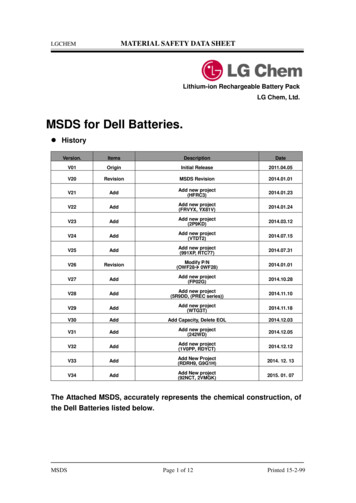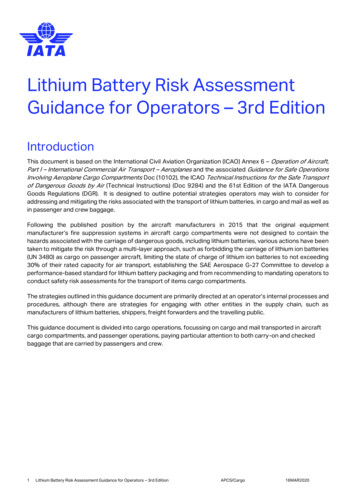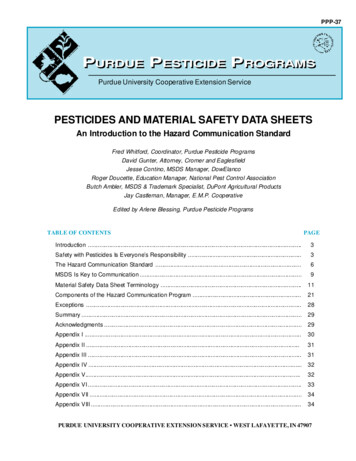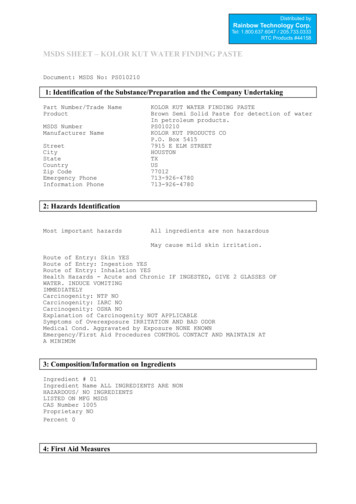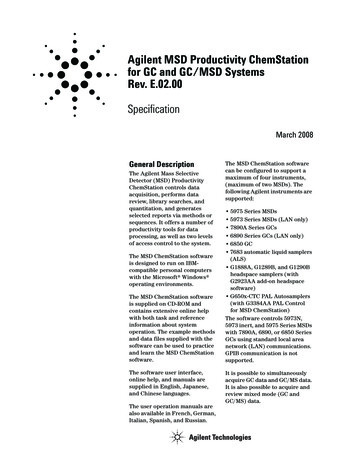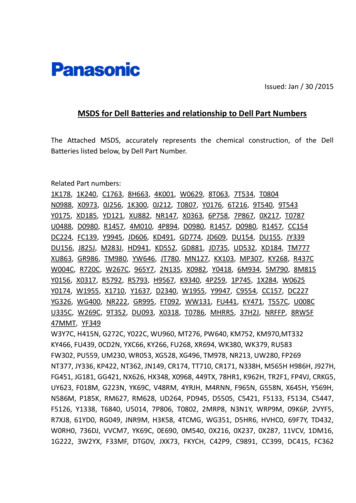
Transcription
Issued: Jan / 30 /2015MSDS for Dell Batteries and relationship to Dell Part NumbersThe Attached MSDS, accurately represents the chemical construction, of the DellBatteries listed below, by Dell Part Number.Related Part numbers:1K178, 1K240, C1763, 8H663, 4K001, W0629, 8T063, 7T534, T0804N0988, X0973, 0J256, 1K300, 0J212, T0807, Y0176, 6T216, 9T540, 9T543Y0175, XD185, YD121, XU882, NR147, X0363, 6P758, 7P867, 0X217, T0787U0488, D0980, R1457, 4M010, 4P894, D0980, R1457, D0980, R1457, CC154DC224, FC139, Y9945, JD606, KD491, GD774, JD609, DU154, DU155, JY339DU156, J825J, M283J, HD941, KD552, GD881, JD735, UD532, XD184, TM777XU863, GR986, TM980, YW646, JT780, MN127, KX103, MP307, KY268, R437CW004C, R720C, W267C, 965Y7, 2N135, X0982, Y0418, 6M934, 5M790, 8M815Y0156, X0317, R5792, R5793, H9567, K9340, 4P259, 1P745, 1X284, W0625Y0174, W1955, X1710, Y1637, D2340, W1955, Y9947, C9554, CC157, DC227YG326, WG400, NR222, GR995, FT092, WW131, FU441, KY471, T557C, U008CU335C, W269C, 9T352, DU093, X0318, T0786, MHRR5, 37H2J, NRFFP, 8RW5F47MMT, YF349W3Y7C, H415N, G272C, Y022C, WU960, MT276, PW640, KM752, KM970,MT332KY466, FU439, 0CD2N, YXC66, KY266, FU268, XR694, WK380, WK379, RU583FW302, PU559, UM230, WR053, XG528, XG496, TM978, NR213, UW280, FP269NT377, JY336, KP422, NT362, JN149, CR174, TT710, CR171, N338H, M565H H986H, J927H,FG451, JG181, GG421, NX626, HX348, X0968, 449TX, 78HR1, K962H, TR2F1, FP4VJ, CRKG5,UY623, F018M, G223N, YK69C, V48RM, 4YRJH, M4RNN, F965N, G558N, X645H, Y569H,N586M, P185K, RM627, RM628, UD264, PD945, D5505, C5421, F5133, F5134, C5447,F5126, Y1338, T6840, U5014, 7P806, T0802, 2MRP8, N3N1Y, WRP9M, 09K6P, 2VYF5,R7XJ8, 61YD0, RG049, JNR9M, H3K58, 4TCMG, WG351, D5HR6, HVHC0, 69F7Y, TD432,W0RH0, 736DJ, VVCM7, YK69C, 0E690, 0M540, 0X216, 0X237, 0X287, 11VCV, 1DM16,1G222, 3W2YX, F33MF, DTG0V, JXK73, FKYCH, C42P9, C9891, CC399, DC415, FC362
GC9R0, X463J, KR174, NU209, 5XR317, 1691P, M597J, N928M, 2M400, 0M540, 9K740H1388, 5X317, 75UYF, 7P066, 3K585, X1979, Y1909, RW220, WN971, MM158, HR047YW652, CW666, HX306, RMTVC, 1G765, 1J127, 1J989, 1X365, 2H660, 2M400, 2P6902M400, 2P690, 2P692, 3J426, 3TWCP, 4E368, 4E369, 4G344, 4K085, 4M778, 4P2545G379, 5J005, 5J436, 5P611, 6T087, 6T475, 6T684, 6T751, 6Y912, 7W238, 8C612, 8P1408T016, 8T273, 8T531, 8T533, 95T96, 9H048, 9H321, 9H348, 9K740, 9T5019W942, C1408, C224P, C310K, C5444, C5454, C9876, CC379, CR160, CR172CR177, D1437, D225P, D5546, D5550, D5556, DF230, DU128, DU138, DU151F5122, FF231, FF232, FT078, FW255, G189K, G2103, G3399, G900G, GP973GW241, H1389, HP277, HW358, HW421, HX345, HX351, J1379, J9324, JD605JG168, JG917, JN145, JN146, JX76F, JX76F, JY327, K880K, KC866, KD489, KD490, KG126, KP405, KPD66, M539G, M846H, MR317, MT275, MX27W, ND865NT380, NX618, NX629, NX632, P773K, PR693, PU500, RD300, RK544, RK818RM803, T0803, T0805, TC020, TD116, TD611, TD612, TK369, TM787, TR321TR520, TR653, TT712, TT717, TT720, TT721, U0485, U0519, U0520, U0521U0522, U1700, U4974, U6256, U8735, UD087, UD260, UD533, UM178UM181, W0596, W0597, W0628, W1815, W1824, W5P4F, WD414, WR015WT619, WT873, X0319, X0362, X0981, X6304, X6347, X8483, XD735, XG513XG527, XG530, XT816, XT827, XU827, XU877, Y0517, Y0518, Y0173, YY0394Y0417, Y0423, Y1082, Y1087, Y265J, Y267J, Y4460, Y4465, Y4498, Y4501Y6160, G278C, V79Y0, RMTVY, C42P9, FKYCH, 9PCR0, NY38W, R2D9M, NH6K9F33MF, 3W2YX, Y0WYY, V7M6R, 3NPC0, C1JKH, 911MD, TPMCF, 6FNTVNGW79, TRM4D, RGR3V, YCFRN, KY1TV, V3JDM, CT4V5, 4WY7C, 163DRH048N, 8X70T, DG219, H91MK, DG219, 0P60Y, 96JC9, D10H3, 6R1V8, 716YDPPJMY, 4FJXY, D10H3, Y1FGD, FJTXY, 70NFJ, M7T5F, 1N9C0, PKH18, 6HY597VJMH, R0JM6, YD8XC, R9XM9, 4K8YH, KKHY1, YDN87, 6P0CC, 5K1GW, 0DRRP,G05H0, 410GJ, YKWXX, 6KK8F, V3716, 29TVH, FJCY5, 8DJT9, F1KTM, 954DF,79VRK, WYT3M, 2XNYN, 5X3XT, VD1WF, 5NJTT, 37CT1, 70K80, 7VJMHThe underline part numbers was originally assigned to Sanyo and Panasonichave merged and therefore these numbers have been moved into theSanyo Master MSDS
Product name: Lithium ion rechargeable battery cellReference number: SDS-IBT-00026Establishment / Revision: Jan. 1, 2015Safety data sheet for product1. PRODUCT AND COMPANY IDENTIFICATION・Product name: Lithium ion rechargeable battery cell・Product code: None(All models Sanyo manufactured and whose capacity is less than or equal to 5.4Ah,including the cell branded as Panasonic, excluding the cell whose shape is prismatic and twoor more side of short / middle / long side excess 12mm/85mm/110mm.)・Company name:Sanyo Electric Co., Ltd.・Address:222-1 , Kaminaizen, Sumoto City, Hyogo, Japan・Telephone number: 81-799-24-4111・Fax number: 81-799-23-2879・Emergency telephone number: [Weekday] 81-799-23-3931[Night and holiday] 81-799-24-41312. HAZARDS IDENTIFICATION・GHS Classification : Not available(This product is outside the scope of GHS system since it's considered as an "article".)For the battery cell, chemical materials are stored in a hermetically sealed metal or metal laminatedplastic case, designed to withstand temperatures and pressures encountered during normal use. As aresult, during normal use, there is no physical danger of ignition or explosion and chemical danger ofhazardous materials' leakage.However, if exposed to a fire, added mechanical shocks, decomposed, added electric stress by missuse, the gas release vent will be operated. The battery cell case will be breached at the extreme,hazardous materials may be released.Moreover, if heated strongly by the surrounding fire, acrid gas may be emitted.・Most important hazard and effectsHuman health effects:Inhalation: The steam of the electrolyte has an anesthesia action and stimulates a respiratory tract.Skin contact: The steam of the electrolyte stimulates a skin. The electrolyte skin contact causes a soreand stimulation on the skin.Eye contact: The steam of the electrolyte stimulates eyes. The electrolyte eye contact causes a soreand stimulation on the eye. Especially, substance that causes a strong inflammation of the eyes iscontained.Environmental effects: Since a battery cell remains in the environment, do not throw out it into theenvironment.・Specific hazards:If the electrolyte contacts with water, it will generate detrimental hydrogen fluoride.Since the leaked electrolyte is inflammable liquid, do not bring close to fire.3. COMPOSITION / INFORMATION ON INGREDIENTS・Substance or preparation: Preparation・Information about the chemical nature of product: *1PortionMaterial namePositive electrodePositive electrode’s baseNegative electrodeNegative electrode’s baseElectrolyteConcentrationrange (wt %)20 601 1010 301 155 25Lithium transition metal oxidate (Li[M]m[O]n *2)AluminumCarbonCopperOrganic electrolyte principally involves estercarbonateOuter caseAluminum, iron, aluminum laminated plastic1 30*1 Not every product includes all of these materials.*2 The letter M means transition metal and candidates of M are Co, Mn, Ni and Al. One compoundincludes one or more of these metals and one product includes one or more of the compounds.The letter m and n means the number of atoms.1/4
Product name: Lithium ion rechargeable battery cellReference number: SDS-IBT-00026Establishment / Revision: Jan. 1, 20154. FIRST-AID MEASURESSpilled internal cell materials・Inhalation:Make the victim blow his/her nose, gargle. Seek medical attention if necessary.・Skin contact:Remove contaminated clothes and shoes immediately. Wash extraneous matter or contact region withsoap and plenty of water immediately.・Eye contact:Do not rub one’s eyes. Immediately flush eyes with water continuously for at least 15 minutes. Seekmedical attention immediately.A battery cell and spilled internal cell materials・Ingestion:Make the victim vomit. When it is impossible or the feeling is not well after vomiting, seek medicalattention.5. FIRE-FIGHTING MEASURE・Suitable extinguishing media: Plenty of water, carbon dioxide gas, nitrogen gas, chemical powder fireextinguishing medium and fire foam.・Specific hazards: Corrosive gas may be emitted during fire.・Specific methods of fire-fighting: When the battery burns with other combustibles simultaneously, take fireextinguishing method which correspond to the combustibles. Extinguish a fire from the windward as muchas possible.・Special protective equipment for firefighters:Respiratory protection: Respiratory equipment of a gas cylinder style or protection-against-dust maskHand protection: Protective glovesEye protection: Goggle or protective glasses designed to protect against liquid splashesSkin and body protection: Protective cloth6. ACCIDENTAL RELEASE MEASURESSpilled internal cell materials, such as electrolyte leaked from a battery cell, are carefully dealt withaccording to the followings.・Precautions for human body:Remove spilled materials with protective equipment (protective glasses and protective gloves). Do notinhale the gas as much as possible. Moreover, avoid touching with as much as possible.・Environmental precautions: Do not throw out into the environment.・Method of cleaning up: The spilled solids are put into a container. The leaked place is wiped off with drycloth.・Prevention of secondary hazards: Avoid re-scattering. Do not bring the collected materials close to fire.7. HANDLING AND STORAGE・Handling suggestions・Do not connect the positive terminal to the negative terminal with electrical wire or chain.・Avoid polarity reverse connection when installing the battery to an instrument.・Do not wet the battery with water, seawater, drink or acid; or expose to strong oxidizer.・Do not damage or remove the external tube.・Keep the battery away from heat and fire.・Do not disassemble or reconstruct the battery; or solder the battery directly.・Do not give a mechanical shock or deform.・Do not use unauthorized charger or other charging method. Terminate charging when the chargingprocess doesn’t end within specified time.・Storage・Do not store the battery with metalware, water, seawater, strong acid or strong oxidizer.・Make the charge amount 30 50% then store at room temperature or less (temperature -20 35 degreeC) in a dry (humidity: 45 85%) place. Avoid direct sunlight, high temperature, and high humidity.・Use insulative and adequately strong packaging material to prevent short circuit between positive andnegative terminal when the packaging breaks during normal handling. Do not use conductive or easy tobreak packaging material.2/4
Product name: Lithium ion rechargeable battery cellReference number: SDS-IBT-00026Establishment / Revision: Jan. 1, 20158. EXPOSURE CONTROLS / PERSONAL PROTECTION (WHEN THE ELECTROLYTE LEAKS)・Control parametersACGIH has not been mentioned control parameter of electrolyte.・Personal protective equipmentRespiratory protection: Respirator with air cylinder, dust maskHand protection: Protective glovesEye protection: Goggle or protective glasses designed to protect against liquid splashesSkin and body protection: Working clothes with long sleeve and long trousers9. PHYSICAL AND CHEMICAL PROPERTIES・AppearancePhysical state: SolidForm: Cylindrical or Prismatic or Pouch (laminated)Color: Metallic color or black(without tube if it has tube)Odor: No odor10. STABILITY AND REACTIVITY・Stability: Stable under normal use・Hazardous reactions occurring under specific conditions・Conditions to avoid: When a battery cell is exposed to an external short-circuit, crushes, deformation,high temperature above 100 degree C, it will be the cause of heat generation and ignition. Direct sunlightand high humidity.・Materials to avoid: Conductive materials, water, seawater, strong oxidizers and strong acids.・Hazardous decomposition products: Acrid or harmful gas is emitted during fire.11. TOXICOLOGICAL INFORMATIONOrganic Electrolyte・Acute toxicity:LD50, oral - Rat 2,000mg/kg or more・Irritating nature: Irritative to skin and eye12. ECOLOGICAL INFORMATION・Persistence/degradability:Since a battery cell and the internal materials remain in the environment, do not bury or throw out into theenvironment.13. DISPOSAL CONSIDERATIONS・Recommended methods for safe and environmentally preferred disposal:Product (waste from residues)Specified collection or disposal of lithium ion battery is required by the law like as "battery control law" inseveral nations. Collection or recycle of the battery is mainly imposed on battery's manufacturer or importerin the nations recycle is required.Contaminated packagingNeither a container nor packing is contaminated during normal use. When internal materials leaked from abattery cell contaminates, dispose as industrial wastes subject to special control.14. TRANSPORT INFORMATIONIn the case of transportation, avoid exposure to high temperature and prevent the formation of anycondensation. Take in a cargo of them without falling, dropping and breakage. Prevent collapse of cargo pilesand wet by rain. The container must be handled carefully. Do not give shocks that result in a mark of hittingon a cell. Please refer to Section 7-HANDLING AND STORAGE also.UN regulation・UN number: 3480 (3481 when the battery is contained in equipment or packed with equipment)・Proper shipping name:Lithium ion batteries (“lithium ion batteries contained in equipment” or “lithium ion batteries packed withequipment”)・Class: 9 *・Packing group: II ** However this product is defined as above, it is not recognized as "DANGEROUS GOODS" or is treated asalmost non-DANGEROUS GOODS when its transport condition accords with instructions or provisionsdepend on region and transportation mode.3/4
Product name: Lithium ion rechargeable battery cellReference number: SDS-IBT-00026Establishment / Revision: Jan. 1, 2015About the instructions or provisions, please see descriptions in box brackets of following regulations.Regulation depends on region and transportation mode・Worldwide, air transportation:IATA-DGR [As non-DANGEROUS GOODS: "packing instruction 965 section II" /Almost as above however displayed as DANGEROUS GOODS: "packing instruction 965 section IB"](When batteries are packaged with equipments or contained in equipments, refer packing instruction 966or 967 instead of 965.)・Worldwide, sea transportation:IMO-IMDG Code [special provision 188]・Europe, road transportation:ADR [special provision 188]15. REGULATORY INFORMATION・Regulations specifically applicable to the product:Wastes Disposal and Public Cleaning Law [Japan]Law for Promotion of Effective Utilization of resources [Japan]US Department of Transportation 49 Code of Federal Regulations [USA]* About overlapping regulations, please refer to Section 14-TRANSPORT INFOMATION.16. OTHER INFORMATION・This safety data sheet is offered an agency who handles this product to handle it safely.・The agency should utilize this safety data sheet effectively (put it up, educate person in charge) and takeproper measures.・The information contained in this Safety data sheet is based on the present state of knowledge andcurrent legislation.・This safety data sheet provides guidance on health, safety and environmental aspects of the product andshould not be construed as any guarantee of technical performance or suitability for particular applications.ReferenceDangerous Goods Regulations – 56th Edition Effective 1 January 2015: International Air TransportAssociation (IATA)IMDG Code – 2014 Edition: International Maritime Organization (IMO)The European Agreement concerning the International Carriage of Dangerous Goods by Road – 2015:The United Nations Economic Commission for Europe (UNECE)First edition:Apr. 28, 2010Prepared and approved byTechnical Administration GroupPortable Rechargeable Battery Business DivisionSanyo Electric Co., Ltd.4/4
MSDS for Dell Batteries and relationship to Dell Part Numbers The Attached MSDS, accurately represents the chemical construction, of the Dell Batteries listed below, by Dell Part Number. Related Part numbers: 1K178, 1K240, C1763, 8H663, 4K001, W0629, 8T063, 7T534, T0804
